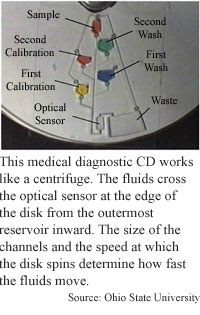
Lab-on-a-CD corrects itself
By Eric Smalley, Technology Research NewsAdding to an ongoing effort to turn the lowly CD player into a medical laboratory, researchers have developed a method of calibrating the optical sensor on a diagnostic compact disc.
The calibration method is a major step forward in an effort that already includes techniques for carving channels and reservoirs in compact discs with the aim of allowing a computer and CD drive to replace laboratory equipment for analyzing blood, saliva and urine samples. The channels will allow fluids from different reservoirs to be combined as the CD spins. The CD player's laser will power an optical sensor that will analyze the prepared sample.
The researchers built a two-point calibration system on the compact disc by carefully positioning four reservoirs -- two for washes and two for calibrating fluids -- between the sample reservoir and the optical sensor, and then programming the CD player to spin the disk at different rpm's in order to move the fluids across the sensor at the appropriate times. (See photo)
Calibrating sensors is a basic analytical function, said Marc Madou, professor of chemistry and material science and engineering at Ohio State University, and director of the NSF Center for Industrial Sensors and Measurements. "If you do a pH measurement, the first thing you would do is calibrate the sensor," he said.
Being able to calibrate a CD's optical sensors is critical because the sensors' sensitivity changes as they age and they would otherwise have no shelf life, he added.
Two-point calibration is important because if you plot the sensitivity of the sensor as a curve, you have to plot at least two points on that curve to accurately measure -- and therefore correct -- changes, Madou said. Two-point calibration is common for laboratory equipment.
"I think [CD-based medical testing] is a very good idea, because… you can have sample preparation and also read out just in a CD drive," said Chih-Ming Ho, professor of mechanical and aerospace engineering and head of UCLA's Micro Systems Laboratories.
CDs are a good platform for medical diagnostics for several reasons, Madou said.
Most important, a CD is a good platform for sample preparation, he said. "Let's say you want to do a DNA analysis. You could put the sample of cells in there and… set up fluidic structures that can break [down] the cell, extract the DNA and even do [the] DNA analysis."
The CD is also inexpensive. "We use established CD stamping methodology [and] player technology for the manufacture of the instrument and [CD]," he said. And the CD can include software and data including instructions on how to run the tests and interpret the results, he said.
Madou is continuing to develop the CD platform by looking for more uses for the CD's laser. "We're looking at how we can energize reactions, perhaps by light," he said. If the laser is powerful enough, it might even be possible for the system to perform polymerase chain reaction (PCR), the technique laboratories use to amplify DNA samples, he said.
The CD technology could be used for a test to determine blood type within a year, Madou said. The research is funded by NASA and the National Science Foundation.
Timeline: <1 year
Funding: Government
TRN Categories: MicroElectroMechanical Systems (MEMS)
Story Type: News
Related Elements: Photo
Advertisements:
October 4, 2000
Page One
DNA does logic
Quantum quirk promises smaller circuits
Pop-up book melds real with virtual
Lab-on-a-CD corrects itself
Linked particles advance quantum computing

News:
Research News Roundup
Research Watch blog
Features:
View from the High Ground Q&A
How It Works
RSS Feeds:
News
Ad links:
Buy an ad link
| Advertisements:
|
 |
Ad links: Clear History
Buy an ad link
|
TRN
Newswire and Headline Feeds for Web sites
|
© Copyright Technology Research News, LLC 2000-2006. All rights reserved.